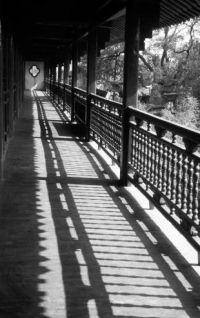History and Milieu (10)

The milieu of storytelling in old Yangzhou
In the outstanding topographical work Yangzhou huafang lu [Reminiscences from the Pleasure Boats of Yangzhou], 1793, the playwright and folklorist Li Dou gives lively descriptions of daily life and customs in Yangzhou. This exceptional author is the first to write in some detail about Yangzhou storytelling and other oral arts. Folklore and the telling and singing arts of the people—shuochang —were generally despised by the intellectuals and scholars of Ming and Qing, and therefore such activities were hardly ever mentioned. Li Dou on the other hand, writes about the contemporary activities of storytelling going on in special pleasure-boats, called 'song boats' gechuan, as well as in teahouses chasi, chashe, wineshops jiulou and storytellers' houses shuchang. The arrangement of the storytellers' houses is described as follows:
There are seats on all four sides. In the middle is the storyteller 's stage. At the door hangs the advertisement: on top three horizontal characters, the name of the storyteller; below four vertical characters, the title of his tale. The owner of the house and the storyteller take turns collecting the income every other day. If the income amounts to one thousand it is considered a reputable feat. These [shuchang] are found in every street and every lane.
Li Dou gives sketchy biographical information about a handful of storytellers and mentions by name more than twenty persons together with their repertoires. The specific brilliance of the performance of the renowned artists is described in short comments. Thus Wu Tianxu, who told the historical epic of San Guo Zhi, was famous for the way he would keep his sound back, so that it was as if it came from the hearts of his audience, rather than from his mouth. Xu Guangru who told Dong Han, and Wang Deshan who told Shuihu Ji, were mentioned among the foremost artists. Among the tales of this period are some that were created by storytellers on autobiographical background, rather than history or legend: Qingfengzha by Pu Lin, The Braggart's Tale Feituo Zhuan by Zou Bixian. These were satirical and highly humorous accounts of the adventures of small gamblers and tricksters on the bottom of the social ladder in town, incorporating a rich amount of local slang.
Yangzhou was a cultural centre where all kinds of performing arts thrived, not only storytelling. There was fruitful contact and influence between the various arts, and many storytellers came from the milieu of opera singers, ballad singers and vice versa. This had deep impact on the performing practice. Many of the famous storytellers were well-educated people who had relinguished the pursuit of an academic career and chosen the life of an artiste. From the end of the eighteenth and the beginning of the nineteenth century we know about many extraordinary storytellers from Yangzhou: Ye Ying (1733-1797), Wang Jingshan (c.1800), Xue Jiahong (c.1800), Jin Guocan (c.1830). Their repertoires were mainly from San Guo, Shuihu, Yue Zhuan and other historical themes.
During the Daoguang period (1821-1851) the economy of Yangzhou was severely damaged, because the two most important enterprises of the town were broken up: the system of the salt monopoly and the grain transportation on the Grand Canal. On top of that, the town was severely devastated under the Taiping Rebellion (1850-1864). The situation was critical for the storytellers ; they had to seek refuge in the countryside and look for new audiences among the peasants and small businessmen. This led to greater mobility of the storytellers, who had earlier mostly practised their art inside the town. Now they began to tour all the hamlets and townships in the surrounding countryside. The audience grew steadily, and at the end of the Qing dynasty there was a regular boom of interest in this entertainment. Some 200-300 hundred storytellers were active in the area. The middle of the eighteenth century inaugurates the period from which we can follow the main schools of Yangzhou storytelling in uninterrupted oral tradition up to the present.
In the twentieth century the geographical and organizational features that formerly gave the town of Yangzhou advantages in the economical sphere have been further undermined, especially since the Shanghai-Nanjing railway was built in the 1930s, passing south of Yangzhou. Left a little out-of-the-way, the town has, however, preserved many old-fashioned characteristics of custom and lifestyle, and the storytellers' art has survived as a living tradition among the inhabitants of the crooked lanes and streets.